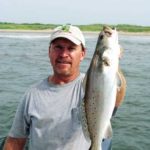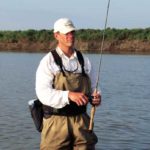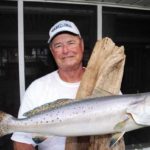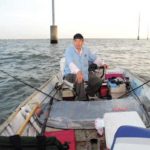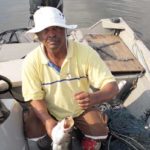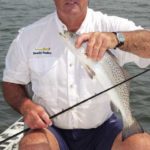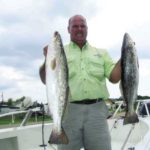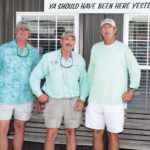
The state’s best speck anglers give inside tips that are sure to put fish in your boat this month.
Louisiana speckled trout fishermen are a dedicated bunch, for the most part fishing year round. But May seems to be a special month, heralding the onset of summer and its hot speck fishing.
But this winter has been extra hard — long, cold and wet. A lot of trout anglers don’t know what to expect. So Louisiana Sportsman consulted with the best sources of trout fishing information we know, the 14 trout masters featured in the wildly popular book Trout Masters: How Louisiana’s Best Anglers Catch the Lunkers.
Lake Pontchartrain
In early April, Dudley Vandenborre, Harry Hildebrand and Chink Sumas agreed that conditions in and around Lake Pontchartrain coming out of the winter were challenging.
“It is pitiful; I can’t remember it like this,” Hildebrand said. “The lake is staying muddy. Right now it looks like Mississippi River water.”
Vandenborre explained that much of the murky water conditions are due to the Pearl River being at flood stage for weeks. From his 51 years of experience, he predicts a below-average spring for speckled trout fishing, but an above-average fall.
“The winter has affected the fish,” he said. “It is making for a slow start in numbers of fish, but I expect that we will catch quality.”
Sumas, known as a Seabrook specialist although he often fishes elsewhere, was a little nervous, but for a different reason.
“It will be different; at least I think so,” he said. “Closing Mr. Go (the Mississippi River Gulf Outlet) can’t help.”
But while he admited it has been cold, he didn’t think that will strongly affect May trout in the deep waters of Seabrook.
All three men described May as usually being a very good speckled trout month. Vandenborre said it is normally the easiest month of the year to catch fish.
Hildebrand, a master of the art of trolling, called May along with November the best trolling months.
“At 65 degrees, all hell breaks loose,” he said. “Trolling is best from 68 to 73 degrees. Then, over 80 degrees it slows down and the fish get smaller. Summer water temperatures make trolling terrible. I just oil my reels until it gets right in the fall.”
Hildebrand recommended trolling the Lake Pontchartrain bridges in May with both rattling hard lures and soft plastics. He added a tip for using soft plastics.
“Put a teaser on your baits,” he said. “I guarantee a teaser will double or triple your catches.”
While he was upbeat about this coming May, he threw a weather eye on the Bonnet Carre Spillway.
“Lord help us if they open that thing up,” he said. “That will be the end of us this spring.”
The versatile Vandenborre was full of recommendations for May. The Causeway and the southshore end of the Trestles should be good, he said, as should the rigs of Bayou Lacombe. The Lake Catherine shoreline should yield some good trout on topwaters.
“Actually, in May there should be fish all over,” he said. “The water has warmed up and the fish have started spawning, so they have to feed a lot. A plus for catching big trout is that they are fattest in May and early June.”
Naturally, Vandenborre recommended the use of his Deadly Dudley line of soft-plastic baits for May trout fishing.
“I like bay choveys in blue moon, opening night or copperhead,” he said. “Copperhead is a bizarre color, but it really catches fish.”
Sumas suggested fishing in the beginning of May with blue moon Deadly Dudley straight tails as a first choice or blue moon with chartreuse tail bay choveys. Then he suggested using live croakers as soon as they become available near the end of the month, even if two have to be put on a hook to provide an attractive bait.
At Seabrook, he’ll fish these, as well as shrimp when they become available in June, one of three ways: under a sliding cork set at 13 feet deep, on a Carolina rig on the bottom with a 1/2-ounce weight and 20-inch leader or freelined with just a swivel, shock leader and hook.
If the fish aren’t biting at Seabrook, especially in early May, Sumas suggested trolling soft-plastic lures on both sides of the rocks by Ballay’s Casino, as well as along the casino wall. Trolling should be done as slowly as possible.
Venice
The Trout Masters who fish the mouth of the Mississippi River also expected a delayed season, due mostly to very high Mississippi River discharges.
Terry St. Cyr and Charlie Lieux both said they wouldn’t be surprised if the mouth of the river wouldn’t turn on until mid to late July.
“We’re fighting a high river,” St. Cyr said, “and I think that this year it will take time for the water to come down and fishing to get right between Breton Sound and Southwest Pass.
“The water in this area can layer a lot, with dirty, fresh water on top and salty, clear water beneath, but river discharges can sometimes just get to be too much. A good west wind can be helpful in making the Sandy Point rigs fishable though.”
Ed Sexton, unofficially the “Mr. Venice” of private-boat trout fishermen, obliquely acknowledged the challenge the high river presents, but didn’t run up a white flag.
“Water condition will be the biggest thing,” he flatly stated. “You have to find some good water.”
Good water is a relative thing to Sexton, who prefers fishing in mixing water over fishing in very clear water.
“If you can see your bait 6 to 8 inches down, don’t be afraid to fish it,” he said.
Sexton, like St. Cyr and Lieux, looks for layered water. One tactic that he uses to find clear water beneath a muddy surface layer is to watch behind his boat to see if the motor’s wheel wash turns up clear water. Sometimes he will run in complete circles to better inspect his tracks.
Most of the fishing Sexton does in May is with artificial lures.
“If the water is clear, I like Deadly Dudley soft plastics in blue moon with chartreuse tails,” he said. “If it is off-colored I use the Campo special color and dip the tails in hot pink Dip-n-Glo.”
Sexton added that one of the tactics he uses in early May is to throw topwater lures to locate fish. If they slap at it but don’t take it, he’ll switch to a Deadly Dudley terror tail or straight tail set 28 to 30 inches beneath a cork.
A high river doesn’t deter Sexton.
“I’m not going to stop fishing because the river is high,” he said. “I’m going to deal with the hand that the good Lord dealt me. I’m going to figure them out. If I stay at home and wait for a good fishing report, it’s too late.”
Grand Isle
Much of Lieux and St. Cyr’s, as well as Bootsie Toups’, prime trout fishing is done farther to the west, along the stretch of coast from the barrier island of Grand Terre westward through Grand Isle and Elmer’s Island to Timbalier Island.
All three men expect speckled trout to turn on in numbers pretty close to when they usually do. That would be late April and on through May and into June.
“The trout will be there,” said St. Cyr with conviction. “There is no doubt about it. We had no fish kill. We had no freeze.”
Toups agreed.
“I don’t think that the cold winter will affect us,” he said. “We’ve had cold winters before. In early May, the shrimp will show up, and every fish you cut up will have shrimp in it.”
But he did admit that too much fresh water from the Mississippi River can slow fishing to a degree.
All three men said anglers should watch short-term local conditions, agreeing that a light southeast wind is best and a west or southwest wind the worst. Toups called a west wind “poison.”
Toups, Lieux and St. Cyr enjoy using live croakers for bait, but all three men cautioned that croakers will be small in May, especially following the cool winter. St Cyr, a dedicated live-bait fisherman, recommended using shrimp, mullet or cocaho minnows if croakers are unavailable or too small.
So did Lieux, who also suggested that anglers try cast netting for pogies in Bayou Rigaud between Sand Dollar Marina and the Coast Guard Station.
“They are easiest to find early in the morning,” he said, “but you can catch them all day. They look like rain on the water as the school moves.”
For anglers who choose to use artificial baits, Lieux suggested big Deadly Dudley blue moon straight tails with their tails tipped in chartreuse Spike It Dip-n-Glo or plugs like Zara Spooks, Corky Fat Boys and Corky Mullets.
One thing that all three were adamant about was that beach fishing was prime in May and that the best fishing, especially for big trout, was to be done in as shallow water as possible.
“I have set the hook on a trout and had a wave wash it up on the beach immediately; that’s how shallow to fish,” Lieux said.
Toups pointed out that for this kind of fishing a boat isn’t needed.
“But,” he cautioned, “don’t wade too far out. Fish the first gulley out from the beach. Throw your bait on top of the bar and pull it into the gulley.”
Finally, St. Cyr pointed out that fishing in the interior areas such as Barataria Bay and Lake Washington turns on even before the beaches do and carries on strong throughout the month of May.
According to St. Cyr, soft plastics under corks will work over any interior reef during the month.
Cypremort Point
Further to the west, in Vermilion Bay and at the reefs outside of Marsh Island, trout fishing success will be dictated by Atchafalaya River discharges, David Billeaud said.
“This looks like it’s going to be the third year in a row with a high river in May,” he said. “For several years before that, we had a low river during May, and fishing was good. Even though we have a month to go before May, I’m going to go out on a limb and predict that it won’t be worth a dang. We will still have too much fresh water and southeast winds.”
But, he added, that if you watch conditions, you can figure them out and then hit them hard until conditions change again.
“They will be feeding good in May, if you can find the right water conditions,” he said.
That means west or southwest winds for the fishing areas outside Marsh Island like Tete Butte Reef or Tiger Shoals.
A tool that Billeaud strongly recommends for anglers who want to follow the plume of Atchafalaya River discharges is “Satellite Imagery of the Louisiana Coast” found on the acadianafishing.com website.
Billeaud fishes soft plastics exclusively, like many other fishermen of the area. He recommends that trout fishermen use the wind and tides to drift over an spot to be fished.
“Leave the trolling motor behind and have your anchor ready,” he suggested. “Be courteous to other anglers.”
Finally, for those anglers who are too impatient to wait for the river to go down and can’t shoehorn trips in when windows of opportunity open, Billeaud offered up some advice: “Go fish Cocodrie.”
The trout aren’t as big there, he explained, but they are willing.
Calcasieu Lake
Farthest to the west, except for little-fished Sabine Lake, is Calcasieu Lake, known affectionately as “Big Lake.” Six Trout Masters fish this lake regularly: Kirk, Guy and Bobby Stansel, Jeff and Mary Poe and Will Drost.
Fishing has been relatively good in the lake this winter, and all of them were upbeat about May.
“May is the turn-on month,” said Guy Stansel. “Everyone gets worked up in April, but May is the month. My personal thing is big trout. There are more big trout caught in May and early June than at any other time.”
“May is a great month, no doubt,” Drost said. “It is a transition month for a wade fisherman like me. The fish move off the shallows along the bank and in and around reefs.”
Mary Poe said May is the month. Lots of big fish are caught and numbers of fish are also there. The birds begin working hard, or “picking,” as Poe calls it, and feeding slicks become common as well.
“The fish are also at their heaviest in May,” she added.
The three Stansels, not surprisingly, share much in their approach to fishing this fabulous month in Big Lake. Each typically starts his morning by fishing topwater lures over reefs. Then, if topwaters don’t work or the bite plays out, they shift to soft plastics. One of Kirk’s favorites is a Texas Trout Killer, made by Texas Tackle Factory, on a ¼-ounce head.
At any time, whether fishing topwater baits or soft plastics, the Stansels stay alert for diving birds and most especially for feeding slicks.
Whether fishing diving birds, reefs or slicks, Bobby Stansel recommended that anglers use their trolling motors only to position themselves, then stop using them and drift through the area to be fished with the wind and currents. Trolling motors, he cautioned, will spook trout, especially large trout, in the 3- to 6-foot-deep waters in which they commonly fish.
Productive reefs that the three men fish include Long Point, Commissary Point, Cross Reef in West Cove, the Washout and Turner’s Bay. Which they fish is determined by wind direction. Those near lee shores will hold clearer water.
Favored topwater lures are a bone-colored Super Spook and a pearl-colored Corky for Kirk, She Dogs in chrome/chartreuse back or in clown color for Bobby and She Dogs in chrome with either a black or chartreuse back for Guy.
Guy admitted to being part of the “Corky craze” that has hit Calcasieu Lake, with his favorite being the Fat Boy in pearl/chartreuse back.
Drost, a self-described plug thrower, was an early devotee of Corky lures. He fishes plugs so exclusively that he doesn’t even own a jig head or plastic lure.
“I know that they’re effective,” he said, “but it’s just not the way I want to fish.”
Drost typically starts a May morning by wade fishing until the day warms up, and then gets back into his boat to fish from it. He starts with topwaters, and then moves to suspending baits if the topwater action isn’t good. May has a lot of calm mornings and windy afternoons, he pointed out. But anglers shouldn’t let wind discourage them from fishing topwater lures. It gives them better action, according to Drost.
I like topwaters,” he said. “They allow me to make long casts and cover a lot of water. I use topwaters to find fish. If I get blow-ups, slaps and short strikes, I can come back with another lure and catch them.”
Drost’s color selection for his lures changes in May away from chartreuse and pink combinations towards more gold, silver and especially bone.
“When I see that sandy green tint in the water, it sets off a light bulb in my head for bone,” he said.
A bone Zara Super Spook is Drost’s favored May lure. He also throws clown-colored or white Spooks with chartreuse heads. Black, a favored winter color, is seldom used in May. Drost admits to throwing jointed Thunder Sticks as well during the month.
Like the Stansels, and Drost, Jeff and Mary Poe are partial to topwater lures in May. But, because the month’s weather is so variable, they stay versatile.
“We will have some nice days,” Jeff said, “but will have some screamers out of the south and one or maybe two cold fronts.”
He added that the majority of their fish in May will be caught on reefs in the southern end of the lake, such as Long Point, Commissary Point and the Rockpile. These reefs are well marked on most fishing maps, with some even giving coordinates.
Mary’s tip of the day is to not venture onto the lake without a good pair of binoculars nor without a fully charged trolling motor battery. Finding sea gulls diving on feeding fish is important in May.
“I’m not too worried about trolling-motor noise on school trout under birds, but I don’t get too close,” she said. “I get just close enough to pick fish off the edges of the school. I don’t try to get close enough to cast into the middle of the birds.
“What you need to do is get in open water 10 or 15 minutes after daylight and shut your motor down and look for activity. Birds will pick best right after daylight and again a couple of hours before dark, even though you can sometimes see them all day.”
She added that if she is targeting big trout, she will work big baits over reefs and slicks rather than fish under diving birds.
“But you have to stay with it,” she said. “You can’t go chase birds.”
Both agree that May is a top drawer month, but Jeff sums it up best.
“I don’t think that you can mess up in May — unless you just don’t go fishing,” he said.
